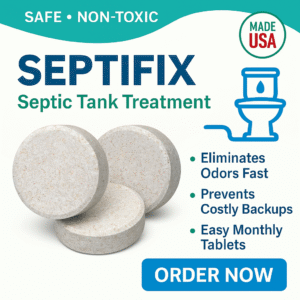If you have a water softener at home, you might wonder: can its backwash be safely discharged into your septic system? This question comes up often for rural homeowners and anyone relying on a septic tank. The truth is, there’s a lot of conflicting information out there—so here’s the simple answer, plus what the experts and code say, risks to watch for, and the best solutions for a healthy, trouble-free septic system.
Quick Picks: Best Water Softener Discharge Solutions
-
Best Overall:
FLECK 5600SXT Water Softener Drain Line Flow Control -
Best Budget:
Neoperl Hose Drain Line Adapter -
Best Premium:
Saniflo Saniswift Grey Water Pump
Buyer’s Guide: Can Water Softener Discharge Go Into a Septic System?
- The Basics: Water softeners regularly flush salt-rich backwash (brine) through a drain line—sometimes directed into septic tanks or drain fields.
- Is It Legal? In many places, yes—it’s legal to discharge water softener brine into a septic tank, but rules can vary by state and county. Always check local codes first.
- What Do Experts Say? Some studies suggest modern septic systems can handle typical amounts of water softener discharge without major problems. However, too much salt or poorly managed systems can spell trouble.
- Main Risks:
- Salt Disrupts Bacteria: High levels of sodium may suppress the good bacteria your septic system needs to break down waste.
- Increased Tank Scum/Sludge: Brine can cause some solids to separate less efficiently, leading to faster buildup and the need for more frequent pumping.
- Possible Soil/Drainfield Issues: Excess salt can affect soil structure, drainage, and plant life around your drainfield.
- Hydraulic Overload: Large, sudden dumps of water can flood your tank and push solids into the drainfield, especially if your system is undersized or already stressed.
- Manufacturer & Code Advice: Most septic pros and system manufacturers recommend discharging water softener backwash elsewhere if possible (such as a dedicated drywell, separate pit, or greywater system) to maximize system life.
Bottom line: While water softener discharge is often allowed in septic systems, it’s not ideal. Directing it elsewhere is always safest for long-term system health.
Full Reviews: Best Products for Water Softener Discharge Management
FLECK 5600SXT Water Softener Drain Line Flow Control
Who it’s for: Anyone who wants to minimize water softener discharge volume and reduce risk to their septic tank.
- Key Benefits:
- Regulates flow for efficient backwash cycles
- Helps prevent septic overload
- Compatible with most major softener brands
- Pros:
- Easy to install and adjust
- Reduces total water use and discharge impact
- Affordable and durable
- Cons:
- Doesn’t remove salt from discharge
- Best as part of a full discharge management plan
Final Verdict: A smart upgrade if you must drain softener backwash to your septic.
Order FLECK Flow Control.
Neoperl Hose Drain Line Adapter
Who it’s for: DIYers looking for a flexible, affordable way to redirect water softener discharge to a dedicated drywell or greywater area.
- Key Benefits:
- Easy hose connection for temporary or permanent setups
- Lets you route discharge away from septic
- Universal fit, works with most softeners
- Pros:
- Cheap and simple solution
- Improves septic protection
- Great for seasonal or backup use
- Cons:
- Manual setup—doesn’t automate discharge
- May not meet all local codes (check first)
Final Verdict: Perfect for homeowners who want to try redirecting softener discharge themselves.
Shop Neoperl Adapter.
Saniflo Saniswift Grey Water Pump
Who it’s for: Homeowners who need to move water softener discharge away from the septic tank or to a distant drywell/yard area.
- Key Benefits:
- Pumps greywater (including softener backwash) up to 14 feet vertically or 140 feet horizontally
- Automatic operation—no manual intervention needed
- Compatible with utility sinks, dishwashers, and more
- Pros:
- Handles all non-sewage water safely
- Great for complex or uphill setups
- Long-lasting and reliable
- Cons:
- Costs more than manual solutions
- Requires power and some plumbing knowledge to install
Final Verdict: The best choice for tough discharge situations or when you want total peace of mind.
See Saniflo Saniswift.
Comparison Table: Water Softener Discharge Solutions
| Name | Key Features | Specs/Capacity | Price Link |
|---|---|---|---|
| FLECK 5600SXT Flow Control | Regulates discharge, easy install | Standard 1/2″ drain line | View Price |
| Neoperl Hose Adapter | Hose adapter for redirection | Universal fit, flexible install | View Price |
| Saniflo Saniswift Pump | Greywater pump, auto | 14 ft vertical, 140 ft horizontal | View Price |
Frequently Asked Questions (FAQ)
Is it illegal to discharge water softener brine into my septic?
In most areas, it’s not illegal—but local codes may restrict or ban it in some regions. Always check with your county or municipal office.
Will water softener salt ruin my septic tank?
It probably won’t “ruin” your tank, but over time, extra salt can disrupt bacteria and soil, leading to reduced performance and possible drainfield problems.
What’s the best way to handle water softener discharge?
Route it to a drywell, dedicated pit, or greywater area if allowed. If it must go to septic, minimize water use and salt load with efficient softener settings.
Do newer water softeners cause fewer problems?
Yes—modern units use less water and salt per cycle, so they’re less risky for septic systems than old, inefficient models.
What signs show my septic isn’t handling discharge well?
Watch for soggy yards, bad odors, slow drains, or the need for more frequent pumping. If you notice these, talk to a septic pro.
Conclusion & Call to Action
While it’s legal in many places to discharge water softener backwash into a septic system, it’s not the best practice. For the longest system life and fewest problems, route the discharge elsewhere or minimize salt and water output. Protect your septic investment with smart products and routine checks!
Want peace of mind? Try one of the recommended discharge solutions above for a cleaner, healthier septic system.
